 Advances in Applied Sociology 2013. Vol.3, No.2, 142-150 Published Online June 2013 in SciRes (http://www.scirp.org/journal/aasoci) http://dx.doi.org/10.4236/aasoci.2013.32019 Copyright © 2013 SciRe s . 142 Education, Work and Reproductive Health among Adolescents in Latin America and the Caribbean Cristina Gomes Latin American Faculty of Social Sciences—FLACSO, Mexi co City, Mexico Email: cristinagomesmx@gmail.com Received January 14th, 2013; revised F eb ruary 16th, 2013; accepted February 25th, 2013 Copyright © 2013 Cristina Gomes. This is an open access article distributed under the Creative Commons At- tribution License, which permits unrestricted use, distribution, and reproduction in any medium, provided the original work is properly cited. Investments in education, work, and the sexual and reproductive health of adolescents and youth contrib- ute to their human development and autonomy, and guarantee that they will have their own resources and pensions for old age. In Latin America and the Caribbean 100 million adolescents aged 10 to 19 years demand schools and teachers in secondary education, employment and health services. This work de- scribes and analyses the situation of adolescents and youths in these three areas of interest, as a basis for defining priorities and the integration of policies oriented to take advantage of the demographic bonus and to enhance the sustainability of future dignified ageing for youth generations. Since Latin America and the Caribbean is the region with the highest inequality rates in the world, investing in demographic divi- dend can also contribute to decreasing inequalities in the long term. Secondary data from censuses, sur- veys and international organizations are analysed to relate to the three relevant issues of interest. Most than half of teens in Central America, and between 20% and 40% of adolescents in South America leave school before completing secondary level education and most of them receive poor quality education, 20% of them do not study or work and some are trapped in a triad of problems: the secondary school dropout, unemployment, informal and unprotected work and adolescent pregnancy. Despite the decline in adolescent fertility rates, they continue to be up to seven times higher among the less educated. Unem- ployment rates are three times higher for young people than for adults, half of them work in informal and low skilled jobs. The relationship between health, education, employment, poverty and inequalities dem- onstrates the need to strengthen and integrate policies of inclusion at school and at work, as well as spe- cial protection and social security for adolescents and youth. Keywords: Youth; Education; Work; Health; Human Development Introduction For more than a decade the population of developing coun- tries has numerous youth and adult cohorts born in times of reduced mortality and high fertility and who are currently in the workforce, while there are few small children and few elderly dependents. Scientific evidence demonstrates that this demo- graphic dividend has contributed to the development (Lee & Manson, 2003), and how this contribution can be enhanced through investments and policies to promote human develop- ment, articulating education, job training, the use of new tech- nologies of information and communication, savings, micro- credit, productive employment, health, social protection and social security. This chain of policies aimed at increasing the skills, income and opportunities of the many generations of teenagers and young adults has become an engine capable of interrupting the cycle of poverty among generations, to promote sustainable development. These trends are particularly evident in some Asian countries. Meanwhile, Latin America has not invested enough in education of adolescents and youth in recent decades; the average number of years of education of the popu- lation is around seven years, and the contribution of the demo- graphic dividend for GDP has been lower than expected (Bloom et al., 2003). To meet and overcome the bottlenecks observed in Latin America, and to make full use of the demographic dividend, it is necessary to take into account the barriers that arise in access to and the quality of the education system, particularly at the completion of secondary school, upper-middle and college. Other barriers are in the family and the social and economic environment of adolescents and youth. Persistent social ine- qualities disenfranchise some teenagers, regardless of the qual- ity of education services and technological inclusion, which are key factors for their productive inclusion in the global labour market. Material and Methods In this article, secondary data on social conditions of the youth is recollected from population censuses, population pro- jections and surveys reports from different Latin American and Caribbean countries. Own estimations and graphics are pre- sented with descriptive analysis and emphasizing inequalities within and among countries in youth population, education, work and health. Comparative data analysis is combined with a revision of relevant publications with statistical results, to build 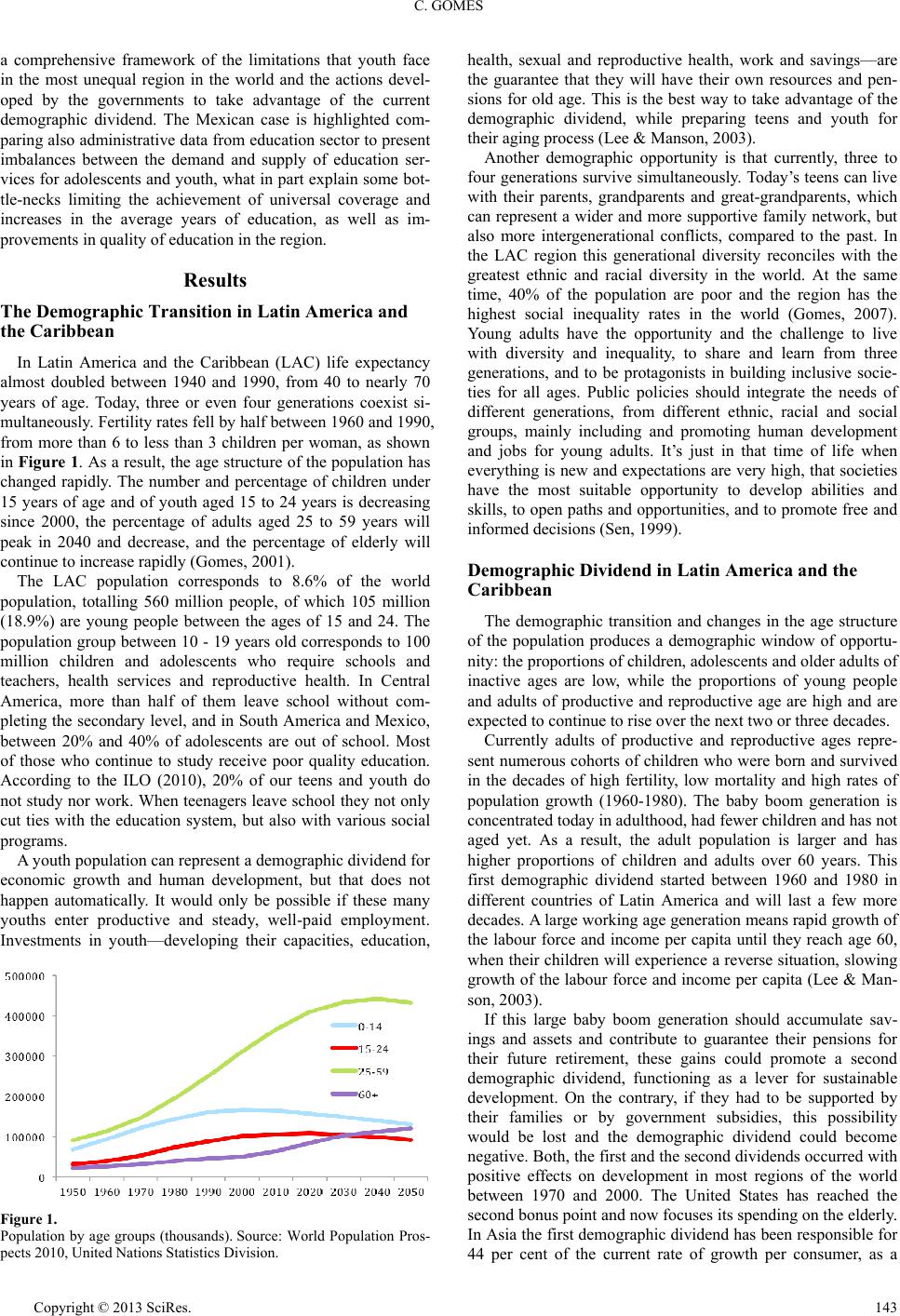 C. GOMES a comprehensive framework of the limitations that youth face in the most unequal region in the world and the actions devel- oped by the governments to take advantage of the current demographic dividend. The Mexican case is highlighted com- paring also administrative data from education sector to present imbalances between the demand and supply of education ser- vices for adolescents and youth, what in part explain some bot- tle-necks limiting the achievement of universal coverage and increases in the average years of education, as well as im- provements in quality of education in the region. Results The Demographic Transition in Latin America and the Caribbean In Latin America and the Caribbean (LAC) life expectancy almost doubled between 1940 and 1990, from 40 to nearly 70 years of age. Today, three or even four generations coexist si- multaneously. Fertility rates fell by half between 1960 and 1990, from more than 6 to less than 3 children per woman, as shown in Figure 1. As a result, the age structure of the population has changed rapidly. The number and percentage of children under 15 years of age and of youth aged 15 to 24 years is decreasing since 2000, the percentage of adults aged 25 to 59 years will peak in 2040 and decrease, and the percentage of elderly will continue to increase rapidly (Gomes, 2001). The LAC population corresponds to 8.6% of the world population, totalling 560 million people, of which 105 million (18.9%) are young people between the ages of 15 and 24. The population group between 10 - 19 years old corresponds to 100 million children and adolescents who require schools and teachers, health services and reproductive health. In Central America, more than half of them leave school without com- pleting the secondary level, and in South America and Mexico, between 20% and 40% of adolescents are out of school. Most of those who continue to study receive poor quality education. According to the ILO (2010), 20% of our teens and youth do not study nor work. When teenagers leave school they not only cut ties with the education system, but also with various social programs. A youth population can represent a demographic dividend for economic growth and human development, but that does not happen automatically. It would only be possible if these many youths enter productive and steady, well-paid employment. Investments in youth—developing their capacities, education, Figure 1. Population by age groups (thousands). Source: World Population Pros- pects 2010, United Nations Statistics Division. health, sexual and reproductive health, work and savings—are the guarantee that they will have their own resources and pen- sions for old age. This is the best way to take advantage of the demographic dividend, while preparing teens and youth for their aging process (Lee & Manson, 2003). Another demographic opportunity is that currently, three to four generations survive simultaneously. Today’s teens can live with their parents, grandparents and great-grandparents, which can represent a wider and more supportive family network, but also more intergenerational conflicts, compared to the past. In the LAC region this generational diversity reconciles with the greatest ethnic and racial diversity in the world. At the same time, 40% of the population are poor and the region has the highest social inequality rates in the world (Gomes, 2007). Young adults have the opportunity and the challenge to live with diversity and inequality, to share and learn from three generations, and to be protagonists in building inclusive socie- ties for all ages. Public policies should integrate the needs of different generations, from different ethnic, racial and social groups, mainly including and promoting human development and jobs for young adults. It’s just in that time of life when everything is new and expectations are very high, that societies have the most suitable opportunity to develop abilities and skills, to open paths and opportunities, and to promote free and informed decisions (Sen, 1999). Demographic Dividend in Latin America and the Caribbean The demographic transition and changes in the age structure of the population produces a demographic window of opportu- nity: the proportions of children, adolescents and older adults of inactive ages are low, while the proportions of young people and adults of productive and reproductive age are high and are expected to continue to rise over the next two or three decades. Currently adults of productive and reproductive ages repre- sent numerous cohorts of children who were born and survived in the decades of high fertility, low mortality and high rates of population growth (1960-1980). The baby boom generation is concentrated today in adulthood, had fewer children and has not aged yet. As a result, the adult population is larger and has higher proportions of children and adults over 60 years. This first demographic dividend started between 1960 and 1980 in different countries of Latin America and will last a few more decades. A large working age generation means rapid growth of the labour force and income per capita until they reach age 60, when their children will experience a reverse situation, slowing growth of the labour force and income per capita (Lee & Man- son, 2003). If this large baby boom generation should accumulate sav- ings and assets and contribute to guarantee their pensions for their future retirement, these gains could promote a second demographic dividend, functioning as a lever for sustainable development. On the contrary, if they had to be supported by their families or by government subsidies, this possibility would be lost and the demographic dividend could become negative. Both, the first and the second dividends occurred with positive effects on development in most regions of the world between 1970 and 2000. The United States has reached the second bonus point and now focuses its spending on the elderly. In Asia the first demographic dividend has been responsible for 44 per cent of the current rate of growth per consumer, as a Copyright © 2013 SciRe s . 143 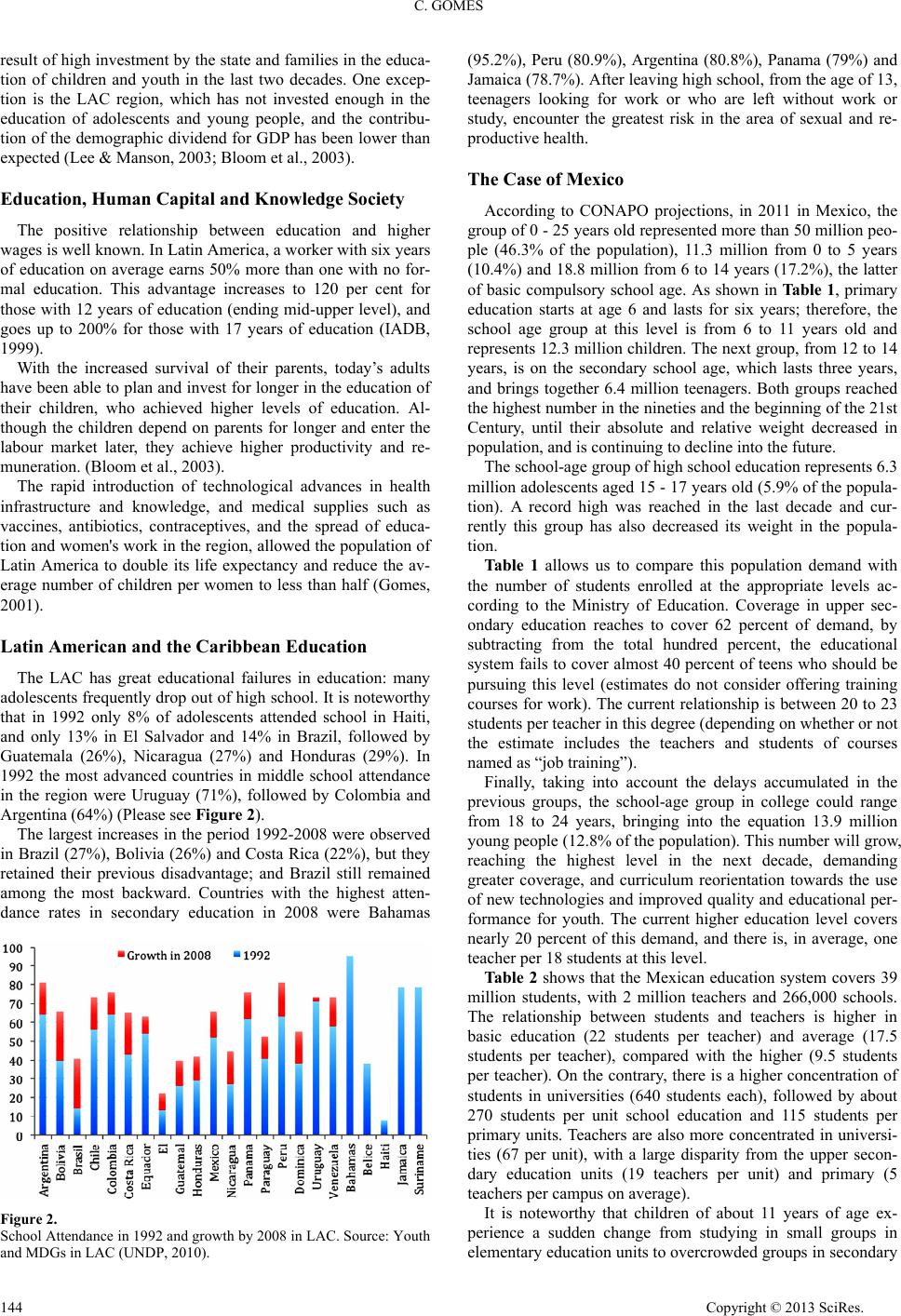 C. GOMES result of high investment by the state and families in the educa- tion of children and youth in the last two decades. One excep- tion is the LAC region, which has not invested enough in the education of adolescents and young people, and the contribu- tion of the demographic dividend for GDP has been lower than expected (Lee & Manson, 2003; Bloom et al., 2003). Education, Human Capital and Knowledge Society The positive relationship between education and higher wages is well known. In Latin America, a worker with six years of education on average earns 50% more than one with no for- mal education. This advantage increases to 120 per cent for those with 12 years of education (ending mid-upper level), and goes up to 200% for those with 17 years of education (IADB, 1999). With the increased survival of their parents, today’s adults have been able to plan and invest for longer in the education of their children, who achieved higher levels of education. Al- though the children depend on parents for longer and enter the labour market later, they achieve higher productivity and re- muneration. (Bloom et al., 2003). The rapid introduction of technological advances in health infrastructure and knowledge, and medical supplies such as vaccines, antibiotics, contraceptives, and the spread of educa- tion and women's work in the region, allowed the population of Latin America to double its life expectancy and reduce the av- erage number of children per women to less than half (Gomes, 2001). Latin American and the Caribbean Education The LAC has great educational failures in education: many adolescents frequently drop out of high school. It is noteworthy that in 1992 only 8% of adolescents attended school in Haiti, and only 13% in El Salvador and 14% in Brazil, followed by Guatemala (26%), Nicaragua (27%) and Honduras (29%). In 1992 the most advanced countries in middle school attendance in the region were Uruguay (71%), followed by Colombia and Argentina (64%) (Please see Figure 2). The largest increases in the period 1992-2008 were observed in Brazil (27%), Bolivia (26%) and Costa Rica (22%), but they retained their previous disadvantage; and Brazil still remained among the most backward. Countries with the highest atten- dance rates in secondary education in 2008 were Bahamas Figure 2. School Attendance in 1992 and growth by 2008 in LAC. Source: Youth and MDGs in LAC (UNDP, 2010). (95.2%), Peru (80.9%), Argentina (80.8%), Panama (79%) and Jamaica (78.7%). After leaving high school, from the age of 13, teenagers looking for work or who are left without work or study, encounter the greatest risk in the area of sexual and re- productive health. The Case of Mexico According to CONAPO projections, in 2011 in Mexico, the group of 0 - 25 years old represented more than 50 million peo- ple (46.3% of the population), 11.3 million from 0 to 5 years (10.4%) and 18.8 million from 6 to 14 years (17.2%), the latter of basic compulsory school age. As shown in Ta ble 1, primary education starts at age 6 and lasts for six years; therefore, the school age group at this level is from 6 to 11 years old and represents 12.3 million children. The next group, from 12 to 14 years, is on the secondary school age, which lasts three years, and brings together 6.4 million teenagers. Both groups reached the highest number in the nineties and the beginning of the 21st Century, until their absolute and relative weight decreased in population, and is continuing to decline into the future. The school-age group of high school education represents 6.3 million adolescents aged 15 - 17 years old (5.9% of the popula- tion). A record high was reached in the last decade and cur- rently this group has also decreased its weight in the popula- tion. Table 1 allows us to compare this population demand with the number of students enrolled at the appropriate levels ac- cording to the Ministry of Education. Coverage in upper sec- ondary education reaches to cover 62 percent of demand, by subtracting from the total hundred percent, the educational system fails to cover almost 40 percent of teens who should be pursuing this level (estimates do not consider offering training courses for work). The current relationship is between 20 to 23 students per teacher in this degree (depending on whether or not the estimate includes the teachers and students of courses named as “job training”). Finally, taking into account the delays accumulated in the previous groups, the school-age group in college could range from 18 to 24 years, bringing into the equation 13.9 million young people (12.8% of the population). This number will grow, reaching the highest level in the next decade, demanding greater coverage, and curriculum reorientation towards the use of new technologies and improved quality and educational per- formance for youth. The current higher education level covers nearly 20 percent of this demand, and there is, in average, one teacher per 18 students at this level. Ta bl e 2 shows that the Mexican education system covers 39 million students, with 2 million teachers and 266,000 schools. The relationship between students and teachers is higher in basic education (22 students per teacher) and average (17.5 students per teacher), compared with the higher (9.5 students per teacher). On the contrary, there is a higher concentration of students in universities (640 students each), followed by about 270 students per unit school education and 115 students per primary units. Teachers are also more concentrated in universi- ties (67 per unit), with a large disparity from the upper secon- dary education units (19 teachers per unit) and primary (5 teachers per campus on average). It is noteworthy that children of about 11 years of age ex- perience a sudden change from studying in small groups in elementary education units to overcrowded groups in secondary Copyright © 2013 SciR es . 144 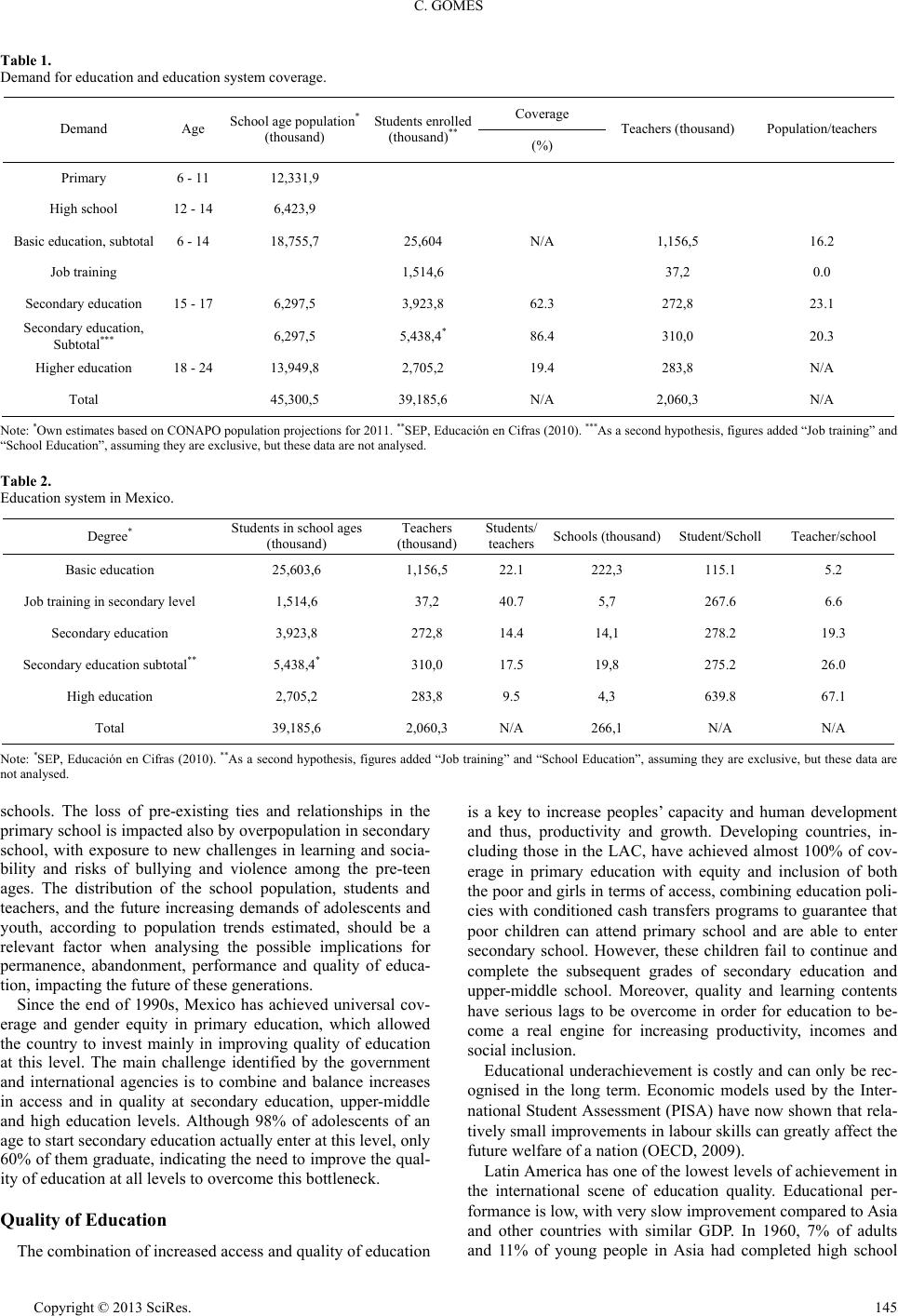 C. GOMES Copyright © 2013 SciRe s . 145 Table 1. Demand for education and educ ation sy stem coverage. Coverage Demand Age School age population* (thousand) Students enrolled (thousand)** (%) Teachers (t h ousand) Population/teachers Primary 6 - 11 12,331,9 High school 12 - 14 6,423,9 Basic e ducation, subtotal 6 - 14 18,755,7 25,604 N/A 1,156,5 16.2 Job training 1,514,6 37,2 0.0 Secondary education 15 - 17 6,297,5 3,923,8 62.3 272,8 23.1 Secondary education, Subtotal*** 6,297,5 5,438,4* 86.4 310,0 20.3 Higher educ ation 18 - 24 13,949,8 2,705,2 19.4 283,8 N/A Total 45,300,5 39,185,6 N/A 2,060,3 N/A Note: *Own estimates based on CONAPO popu lation projections for 2011 . **SEP, Educación en Cifras (2010). ***As a second hypoth esis, figu res add ed “Job trai nin g” and “School Ed ucation”, assuming they are exclusive, b ut these data are not analysed. Table 2. Education system in Mexico. Degree* Students in school ages (thousand) Teachers (thousand) Students/ teachers Schools (thousand)Student/Scholl Teacher/s chool Basic education 25,603,6 1,156,5 22.1 222,3 115.1 5.2 Job training in secondary level 1,514,6 37,2 40.7 5,7 267.6 6.6 Secondary education 3,923,8 272,8 14.4 14,1 278.2 19.3 Secondary education subtotal** 5,438,4* 310,0 17.5 19,8 275.2 26.0 High educa tion 2,705,2 283,8 9.5 4,3 639.8 67.1 Total 39,185,6 2,060,3 N/A 266,1 N/A N/A Note: *SEP, Educación en Cifras (2010). **As a second hypothesis, figures added “Job training” and “School Education”, assuming they are exclusive, but these data are not analysed. schools. The loss of pre-existing ties and relationships in the primary school is impacted also by overpopulation in secondary school, with exposure to new challenges in learning and socia- bility and risks of bullying and violence among the pre-teen ages. The distribution of the school population, students and teachers, and the future increasing demands of adolescents and youth, according to population trends estimated, should be a relevant factor when analysing the possible implications for permanence, abandonment, performance and quality of educa- tion, impacting the future of these generations. Since the end of 1990s, Mexico has achieved universal cov- erage and gender equity in primary education, which allowed the country to invest mainly in improving quality of education at this level. The main challenge identified by the government and international agencies is to combine and balance increases in access and in quality at secondary education, upper-middle and high education levels. Although 98% of adolescents of an age to start secondary education actually enter at this level, only 60% of them graduate, indicating the need to improve the qual- ity of education at all levels to overcome this bottleneck. Quality of Educa ti on The combination of increased access and quality of education is a key to increase peoples’ capacity and human development and thus, productivity and growth. Developing countries, in- cluding those in the LAC, have achieved almost 100% of cov- erage in primary education with equity and inclusion of both the poor and girls in terms of access, combining education poli- cies with conditioned cash transfers programs to guarantee that poor children can attend primary school and are able to enter secondary school. However, these children fail to continue and complete the subsequent grades of secondary education and upper-middle school. Moreover, quality and learning contents have serious lags to be overcome in order for education to be- come a real engine for increasing productivity, incomes and social inclusion. Educational underachievement is costly and can only be rec- ognised in the long term. Economic models used by the Inter- national Student Assessment (PISA) have now shown that rela- tively small improvements in labour skills can greatly affect the future welfare of a nation (OECD, 2009). Latin America has one of the lowest levels of achievement in the international scene of education quality. Educational per- formance is low, with very slow improvement compared to Asia and other countries with similar GDP. In 1960, 7% of adults and 11% of young people in Asia had completed high school 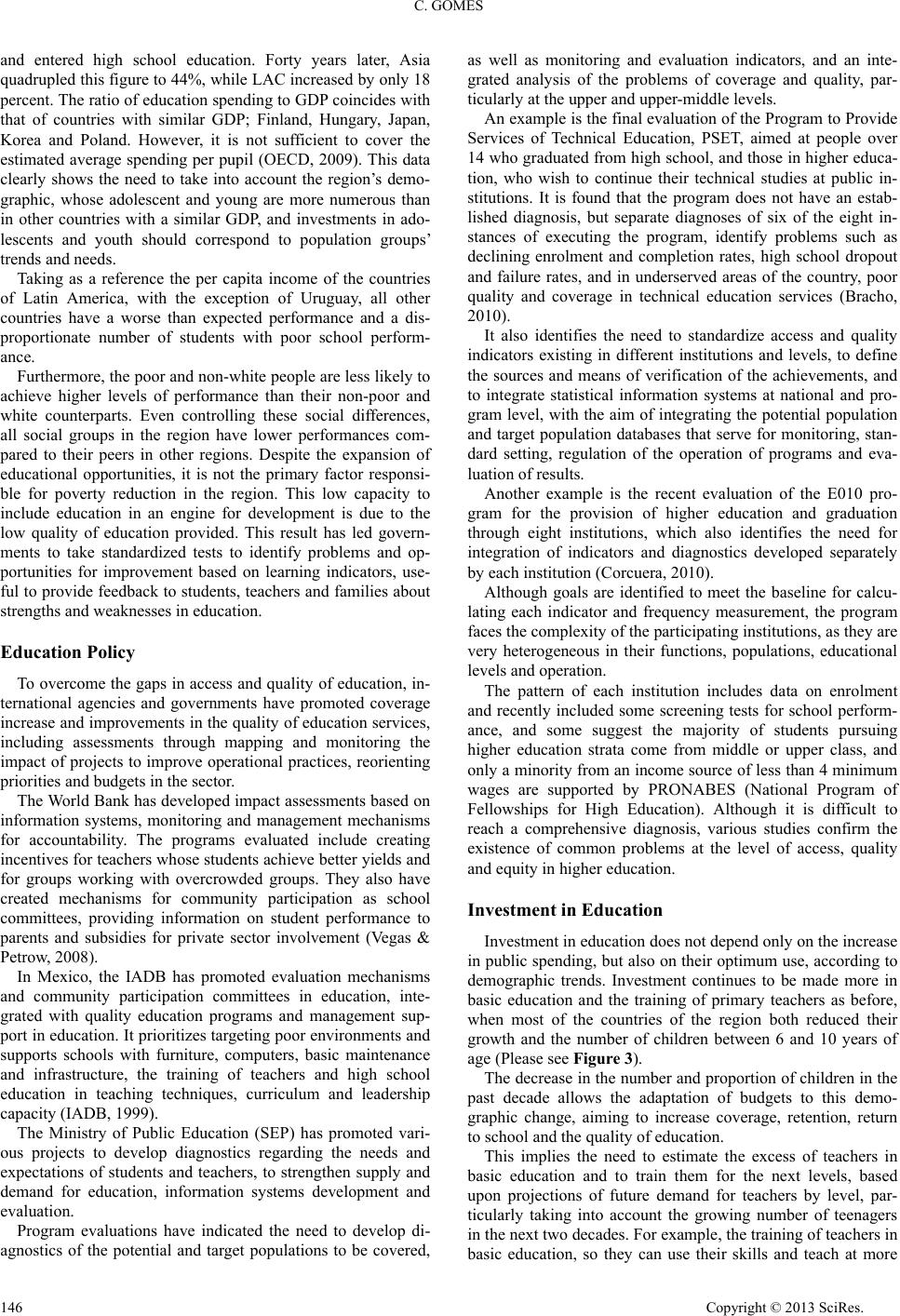 C. GOMES and entered high school education. Forty years later, Asia quadrupled this figure to 44%, while LAC increased by only 18 percent. The ratio of education spending to GDP coincides with that of countries with similar GDP; Finland, Hungary, Japan, Korea and Poland. However, it is not sufficient to cover the estimated average spending per pupil (OECD, 2009). This data clearly shows the need to take into account the region’s demo- graphic, whose adolescent and young are more numerous than in other countries with a similar GDP, and investments in ado- lescents and youth should correspond to population groups’ trends and needs. Taking as a reference the per capita income of the countries of Latin America, with the exception of Uruguay, all other countries have a worse than expected performance and a dis- proportionate number of students with poor school perform- ance. Furthermore, the poor and non-white people are less likely to achieve higher levels of performance than their non-poor and white counterparts. Even controlling these social differences, all social groups in the region have lower performances com- pared to their peers in other regions. Despite the expansion of educational opportunities, it is not the primary factor responsi- ble for poverty reduction in the region. This low capacity to include education in an engine for development is due to the low quality of education provided. This result has led govern- ments to take standardized tests to identify problems and op- portunities for improvement based on learning indicators, use- ful to provide feedback to students, teachers and families about strengths and weaknesses in education. Education Policy To overcome the gaps in access and quality of education, in- ternational agencies and governments have promoted coverage increase and improvements in the quality of education services, including assessments through mapping and monitoring the impact of projects to improve operational practices, reorienting priorities and budgets in the sector. The World Bank has developed impact assessments based on information systems, monitoring and management mechanisms for accountability. The programs evaluated include creating incentives for teachers whose students achieve better yields and for groups working with overcrowded groups. They also have created mechanisms for community participation as school committees, providing information on student performance to parents and subsidies for private sector involvement (Vegas & Petrow, 2008). In Mexico, the IADB has promoted evaluation mechanisms and community participation committees in education, inte- grated with quality education programs and management sup- port in education. It prioritizes targeting poor environments and supports schools with furniture, computers, basic maintenance and infrastructure, the training of teachers and high school education in teaching techniques, curriculum and leadership capacity (IADB, 1999). The Ministry of Public Education (SEP) has promoted vari- ous projects to develop diagnostics regarding the needs and expectations of students and teachers, to strengthen supply and demand for education, information systems development and evaluation. Program evaluations have indicated the need to develop di- agnostics of the potential and target populations to be covered, as well as monitoring and evaluation indicators, and an inte- grated analysis of the problems of coverage and quality, par- ticularly at the upper and upper-middle levels. An example is the final evaluation of the Program to Provide Services of Technical Education, PSET, aimed at people over 14 who graduated from high school, and those in higher educa- tion, who wish to continue their technical studies at public in- stitutions. It is found that the program does not have an estab- lished diagnosis, but separate diagnoses of six of the eight in- stances of executing the program, identify problems such as declining enrolment and completion rates, high school dropout and failure rates, and in underserved areas of the country, poor quality and coverage in technical education services (Bracho, 2010). It also identifies the need to standardize access and quality indicators existing in different institutions and levels, to define the sources and means of verification of the achievements, and to integrate statistical information systems at national and pro- gram level, with the aim of integrating the potential population and target population databases that serve for monitoring, stan- dard setting, regulation of the operation of programs and eva- luation of results. Another example is the recent evaluation of the E010 pro- gram for the provision of higher education and graduation through eight institutions, which also identifies the need for integration of indicators and diagnostics developed separately by each institution (Corcuera, 2010). Although goals are identified to meet the baseline for calcu- lating each indicator and frequency measurement, the program faces the complexity of the participating institutions, as they are very heterogeneous in their functions, populations, educational levels and operation. The pattern of each institution includes data on enrolment and recently included some screening tests for school perform- ance, and some suggest the majority of students pursuing higher education strata come from middle or upper class, and only a minority from an income source of less than 4 minimum wages are supported by PRONABES (National Program of Fellowships for High Education). Although it is difficult to reach a comprehensive diagnosis, various studies confirm the existence of common problems at the level of access, quality and e quity in higher education. Investment in Education Investment in education does not depend only on the increase in public spending, but also on their optimum use, according to demographic trends. Investment continues to be made more in basic education and the training of primary teachers as before, when most of the countries of the region both reduced their growth and the number of children between 6 and 10 years of age (Please see Figure 3). The decrease in the number and proportion of children in the past decade allows the adaptation of budgets to this demo- graphic change, aiming to increase coverage, retention, return to school and the quality of education. This implies the need to estimate the excess of teachers in basic education and to train them for the next levels, based upon projections of future demand for teachers by level, par- ticularly taking into account the growing number of teenagers in the next two decades. For example, the training of teachers in basic education, so they can use their skills and teach at more Copyright © 2013 SciR es . 146 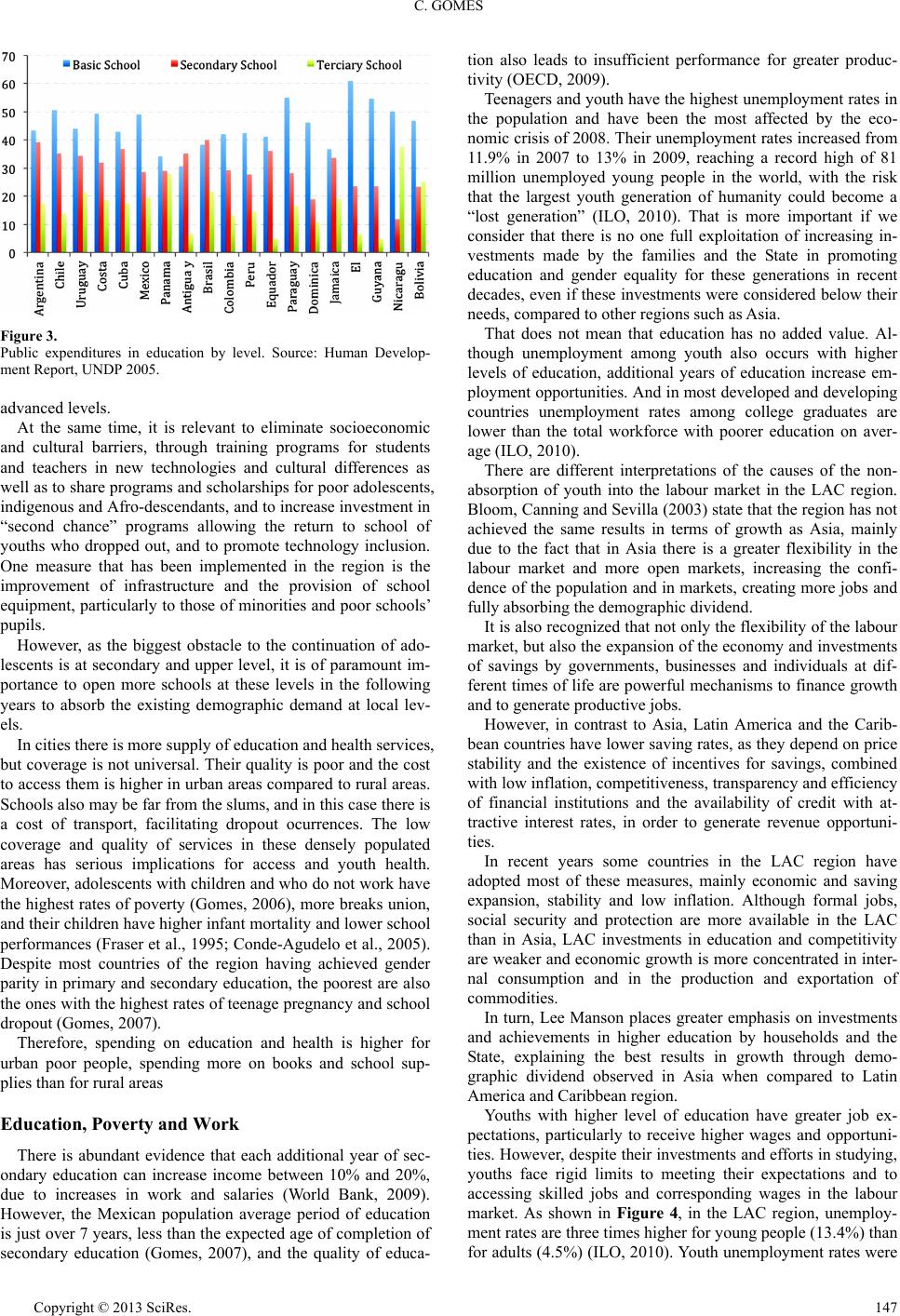 C. GOMES Figure 3. Public expenditures in education by level. Source: Human Develop- ment Report, UNDP 2005. advanced levels. At the same time, it is relevant to eliminate socioeconomic and cultural barriers, through training programs for students and teachers in new technologies and cultural differences as well as to share programs and scholarships for poor adolescents, indigenous and Afro-descendants, and to increase investment in “second chance” programs allowing the return to school of youths who dropped out, and to promote technology inclusion. One measure that has been implemented in the region is the improvement of infrastructure and the provision of school equipment, particularly to those of minorities and poor schools’ pupils. However, as the biggest obstacle to the continuation of ado- lescents is at secondary and upper level, it is of paramount im- portance to open more schools at these levels in the following years to absorb the existing demographic demand at local lev- els. In cities there is more supply of education and health services, but coverage is not universal. Their quality is poor and the cost to access them is higher in urban areas compared to rural areas. Schools also may be far from the slums, and in this case there is a cost of transport, facilitating dropout ocurrences. The low coverage and quality of services in these densely populated areas has serious implications for access and youth health. Moreover, adolescents with children and who do not work have the highest rates of poverty (Gomes, 2006), more breaks union, and their children have higher infant mortality and lower school performances (Fraser et al., 1995; Conde-Agudelo et al., 2005). Despite most countries of the region having achieved gender parity in primary and secondary education, the poorest are also the ones with the highest rates of teenage pregnancy and school dropout (Gomes, 2007). Therefore, spending on education and health is higher for urban poor people, spending more on books and school sup- plies than for rural areas Education, Poverty and Work There is abundant evidence that each additional year of sec- ondary education can increase income between 10% and 20%, due to increases in work and salaries (World Bank, 2009). However, the Mexican population average period of education is just over 7 years, less than the expected age of completion of secondary education (Gomes, 2007), and the quality of educa- tion also leads to insufficient performance for greater produc- tivity (OECD, 2009). Teenagers and youth have the highest unemployment rates in the population and have been the most affected by the eco- nomic crisis of 2008. Their unemployment rates increased from 11.9% in 2007 to 13% in 2009, reaching a record high of 81 million unemployed young people in the world, with the risk that the largest youth generation of humanity could become a “lost generation” (ILO, 2010). That is more important if we consider that there is no one full exploitation of increasing in- vestments made by the families and the State in promoting education and gender equality for these generations in recent decades, even if these investments were considered below their needs, compared to other regions such as Asia. That does not mean that education has no added value. Al- though unemployment among youth also occurs with higher levels of education, additional years of education increase em- ployment opportunities. And in most developed and developing countries unemployment rates among college graduates are lower than the total workforce with poorer education on aver- age (ILO, 2010). There are different interpretations of the causes of the non- absorption of youth into the labour market in the LAC region. Bloom, Canning and Sevilla (2003) state that the region has not achieved the same results in terms of growth as Asia, mainly due to the fact that in Asia there is a greater flexibility in the labour market and more open markets, increasing the confi- dence of the population and in markets, creating more jobs and fully absorbing the demographic dividend. It is also recognized that not only the flexibility of the labour market, but also the expansion of the economy and investments of savings by governments, businesses and individuals at dif- ferent times of life are powerful mechanisms to finance growth and to generate productive jobs. However, in contrast to Asia, Latin America and the Carib- bean countries have lower saving rates, as they depend on price stability and the existence of incentives for savings, combined with low inflation, competitiveness, transparency and efficiency of financial institutions and the availability of credit with at- tractive interest rates, in order to generate revenue opportuni- ties. In recent years some countries in the LAC region have adopted most of these measures, mainly economic and saving expansion, stability and low inflation. Although formal jobs, social security and protection are more available in the LAC than in Asia, LAC investments in education and competitivity are weaker and economic growth is more concentrated in inter- nal consumption and in the production and exportation of commodities. In turn, Lee Manson places greater emphasis on investments and achievements in higher education by households and the State, explaining the best results in growth through demo- graphic dividend observed in Asia when compared to Latin America and Caribbean region. Youths with higher level of education have greater job ex- pectations, particularly to receive higher wages and opportuni- ties. However, despite their investments and efforts in studying, youths face rigid limits to meeting their expectations and to accessing skilled jobs and corresponding wages in the labour market. As shown in Figure 4, in the LAC region, unemploy- ment rates are three times higher for young people (13.4%) than for adults (4.5%) (ILO, 2010). Youth unemployment rates were Copyright © 2013 SciRe s . 147 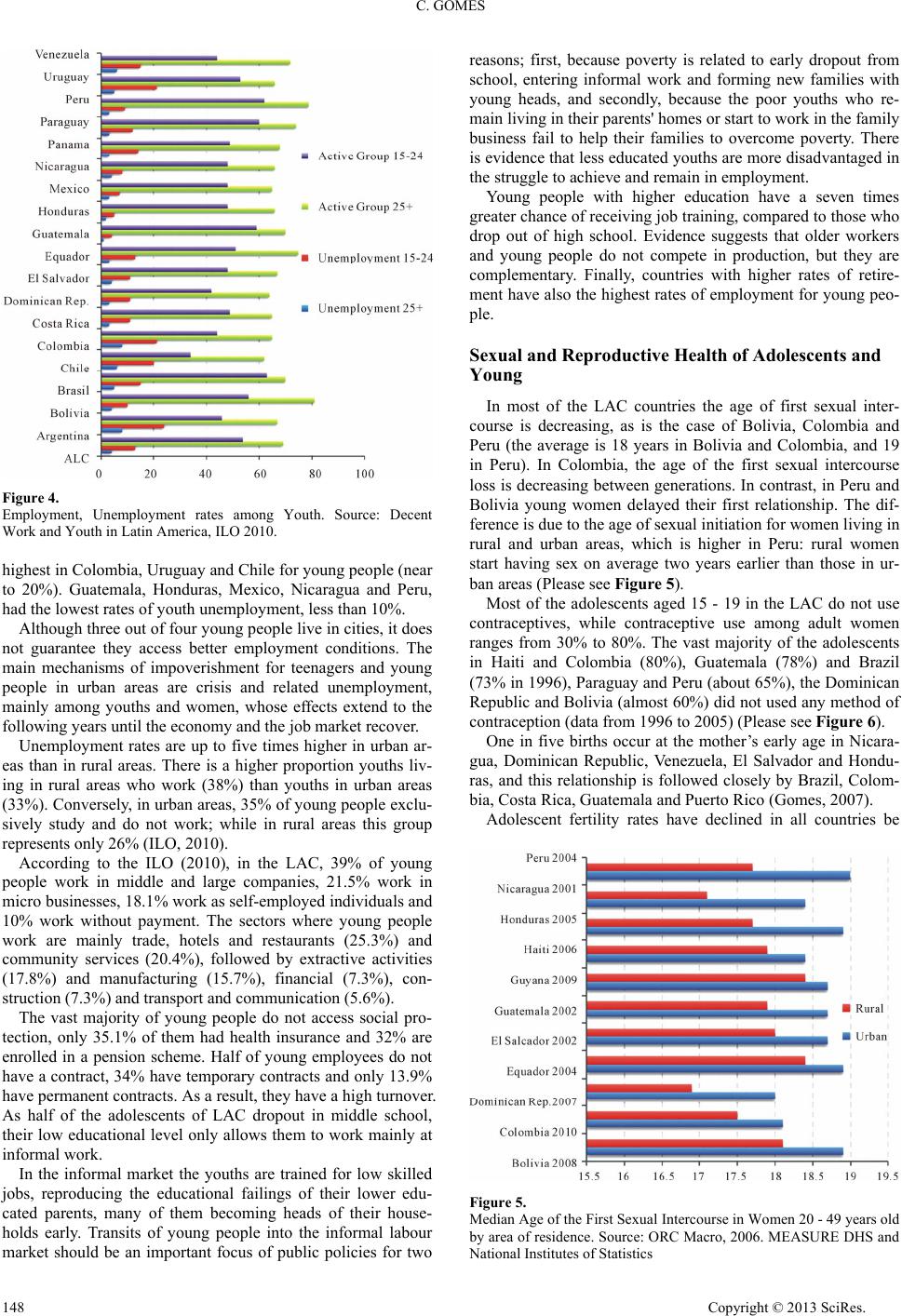 C. GOMES Figure 4. Employment, Unemployment rates among Youth. Source: Decent Work and Youth in Latin Am e rica, ILO 2010. highest in Colombia, Uruguay and Chile for young people (near to 20%). Guatemala, Honduras, Mexico, Nicaragua and Peru, had the lowest rates of youth unemployment, less than 10%. Although three out of four young people live in cities, it does not guarantee they access better employment conditions. The main mechanisms of impoverishment for teenagers and young people in urban areas are crisis and related unemployment, mainly among youths and women, whose effects extend to the following years until th e economy and the job market recover. Unemployment rates are up to five times higher in urban ar- eas than in rural areas. There is a higher proportion youths liv- ing in rural areas who work (38%) than youths in urban areas (33%). Conversely, in urban areas, 35% of young people exclu- sively study and do not work; while in rural areas this group represents only 26% (ILO, 2010). According to the ILO (2010), in the LAC, 39% of young people work in middle and large companies, 21.5% work in micro businesses, 18.1% work as self-employed individuals and 10% work without payment. The sectors where young people work are mainly trade, hotels and restaurants (25.3%) and community services (20.4%), followed by extractive activities (17.8%) and manufacturing (15.7%), financial (7.3%), con- struction (7.3%) and transport and communication (5.6%). The vast majority of young people do not access social pro- tection, only 35.1% of them had health insurance and 32% are enrolled in a pension scheme. Half of young employees do not have a contract, 34% have temporary contracts and only 13.9% have permanent contracts. As a result, they have a high turnover. As half of the adolescents of LAC dropout in middle school, their low educational level only allows them to work mainly at informal work. In the informal market the youths are trained for low skilled jobs, reproducing the educational failings of their lower edu- cated parents, many of them becoming heads of their house- holds early. Transits of young people into the informal labour market should be an important focus of public policies for two reasons; first, because poverty is related to early dropout from school, entering informal work and forming new families with young heads, and secondly, because the poor youths who re- main living in their parents' homes or start to work in the family business fail to help their families to overcome poverty. There is evidence that less educated youths are more disadvantaged in the struggle to achieve and remain in employment. Young people with higher education have a seven times greater chance of receiving job training, compared to those who drop out of high school. Evidence suggests that older workers and young people do not compete in production, but they are complementary. Finally, countries with higher rates of retire- ment have also the highest rates of employment for young peo- ple. Sexual and Reproductive Health of Adolescents and Young In most of the LAC countries the age of first sexual inter- course is decreasing, as is the case of Bolivia, Colombia and Peru (the average is 18 years in Bolivia and Colombia, and 19 in Peru). In Colombia, the age of the first sexual intercourse loss is decreasing between generations. In contrast, in Peru and Bolivia young women delayed their first relationship. The dif- ference is due to the age of sexual initiation for women living in rural and urban areas, which is higher in Peru: rural women start having sex on average two years earlier than those in ur- ban areas (Please see Figure 5). Most of the adolescents aged 15 - 19 in the LAC do not use contraceptives, while contraceptive use among adult women ranges from 30% to 80%. The vast majority of the adolescents in Haiti and Colombia (80%), Guatemala (78%) and Brazil (73% in 1996), Paraguay and Peru (about 65%), the Dominican Republic and Bolivia (almost 60%) did not used any method of contraception (data from 1996 to 2005) (Please see Figure 6). One in five births occur at the mother’s early age in Nicara- gua, Dominican Republic, Venezuela, El Salvador and Hondu- ras, and this relationship is followed closely by Brazil, Colom- bia, Costa Rica, Guatemala and Puerto Rico (Gomes, 2007). Adolescent fertility rates have declined in all countries be Figure 5. Median Age of the First Sexual Intercourse in Women 20 - 49 years old by area of residence. Source: ORC Macro, 2006. MEASURE DHS and National Institutes of Statistics Copyright © 2013 SciR es . 148 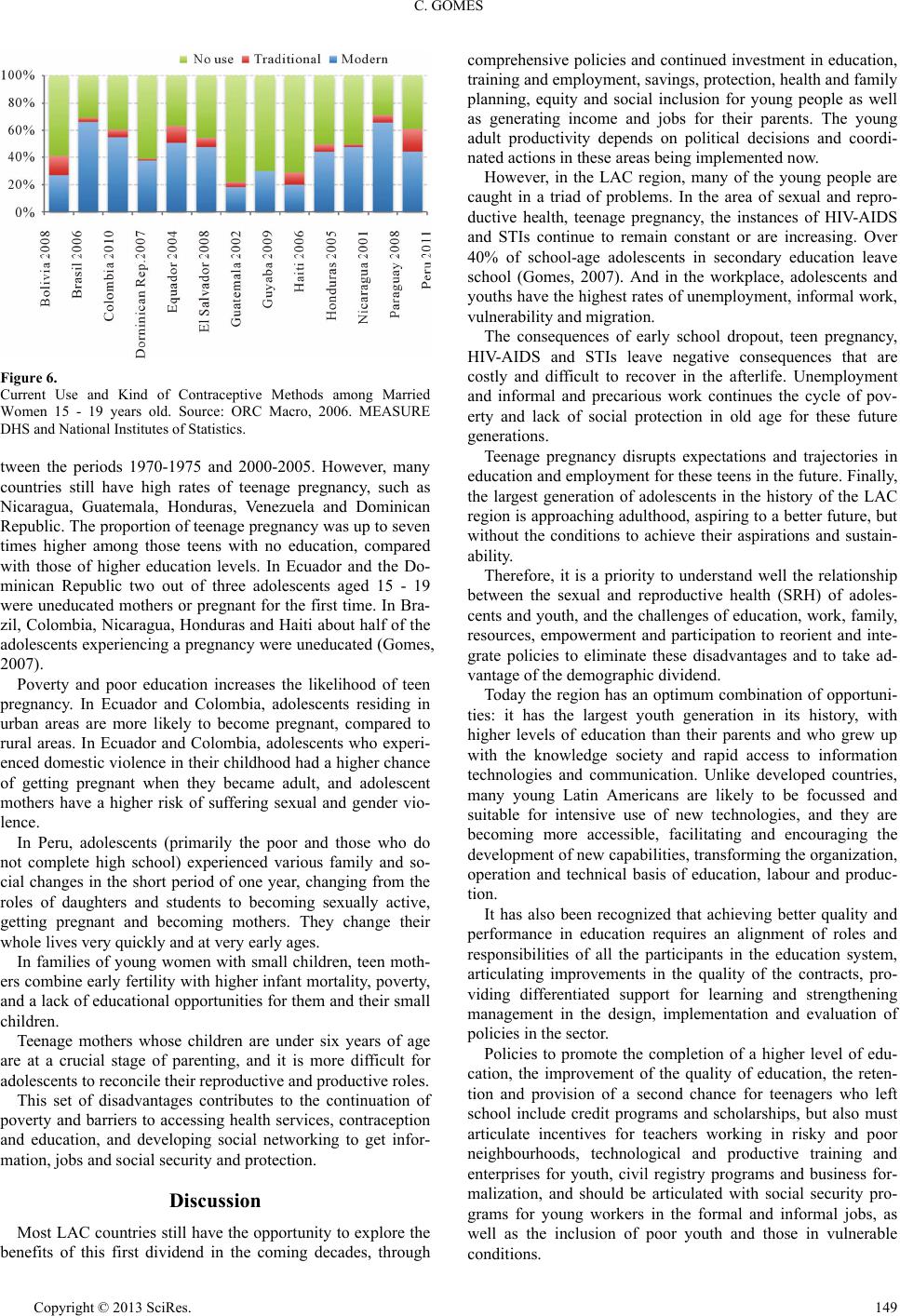 C. GOMES Figure 6. Current Use and Kind of Contraceptive Methods among Married Women 15 - 19 years old. Source: ORC Macro, 2006. MEASURE DHS and National Institutes of Statistics. tween the periods 1970-1975 and 2000-2005. However, many countries still have high rates of teenage pregnancy, such as Nicaragua, Guatemala, Honduras, Venezuela and Dominican Republic. The proportion of teenage pregnancy was up to seven times higher among those teens with no education, compared with those of higher education levels. In Ecuador and the Do- minican Republic two out of three adolescents aged 15 - 19 were uneducated mothers or pregnant for the first time. In Bra- zil, Colombia, Nicaragua, Honduras and Haiti about half of the adolescents experiencing a pregnancy were uneducated (Gomes, 2007). Poverty and poor education increases the likelihood of teen pregnancy. In Ecuador and Colombia, adolescents residing in urban areas are more likely to become pregnant, compared to rural areas. In Ecuador and Colombia, adolescents who experi- enced domestic violence in their childhood had a higher chance of getting pregnant when they became adult, and adolescent mothers have a higher risk of suffering sexual and gender vio- lence. In Peru, adolescents (primarily the poor and those who do not complete high school) experienced various family and so- cial changes in the short period of one year, changing from the roles of daughters and students to becoming sexually active, getting pregnant and becoming mothers. They change their whole lives very quickly and at very early ages. In families of young women with small children, teen moth- ers combine early fertility with higher infant mortality, poverty, and a lack of educational opportunities for them and their small children. Teenage mothers whose children are under six years of age are at a crucial stage of parenting, and it is more difficult for adolescents to reconcile their reproductive and productive roles. This set of disadvantages contributes to the continuation of poverty and barriers to accessing health services, contraception and education, and developing social networking to get infor- mation, jobs and social security and protection. Discussion Most LAC countries still have the opportunity to explore the benefits of this first dividend in the coming decades, through comprehensive policies and continued investment in education, training and employment, savings, protection, health and family planning, equity and social inclusion for young people as well as generating income and jobs for their parents. The young adult productivity depends on political decisions and coordi- nated actions in these areas being implemented now. However, in the LAC region, many of the young people are caught in a triad of problems. In the area of sexual and repro- ductive health, teenage pregnancy, the instances of HIV-AIDS and STIs continue to remain constant or are increasing. Over 40% of school-age adolescents in secondary education leave school (Gomes, 2007). And in the workplace, adolescents and youths have the highest rates of unemployment, informa l work, vulnerability and migration. The consequences of early school dropout, teen pregnancy, HIV-AIDS and STIs leave negative consequences that are costly and difficult to recover in the afterlife. Unemployment and informal and precarious work continues the cycle of pov- erty and lack of social protection in old age for these future generations. Teenage pregnancy disrupts expectations and trajectories in education and employment for these teens in the future. Finally, the largest generation of adolescents in the history of the LAC region is approaching adulthood, aspiring to a better future, but without the conditions to achieve their aspirations and sustain- ability . Therefore, it is a priority to understand well the relationship between the sexual and reproductive health (SRH) of adoles- cents and youth, and the challenges of education, work, family, resources, empowerment and participation to reorient and inte- grate policies to eliminate these disadvantages and to take ad- vantage of the demographic dividend. Today the region has an optimum combination of opportuni- ties: it has the largest youth generation in its history, with higher levels of education than their parents and who grew up with the knowledge society and rapid access to information technologies and communication. Unlike developed countries, many young Latin Americans are likely to be focussed and suitable for intensive use of new technologies, and they are becoming more accessible, facilitating and encouraging the development of new capabilities, transforming the organization, operation and technical basis of education, labour and produc- tion. It has also been recognized that achieving better quality and performance in education requires an alignment of roles and responsibilities of all the participants in the education system, articulating improvements in the quality of the contracts, pro- viding differentiated support for learning and strengthening management in the design, implementation and evaluation of policies in the sector. Policies to promote the completion of a higher level of edu- cation, the improvement of the quality of education, the reten- tion and provision of a second chance for teenagers who left school include credit programs and scholarships, but also must articulate incentives for teachers working in risky and poor neighbourhoods, technological and productive training and enterprises for youth, civil registry programs and business for- malization, and should be articulated with social security pro- grams for young workers in the formal and informal jobs, as well as the inclusion of poor youth and those in vulnerable conditions. Copyright © 2013 SciRe s . 149 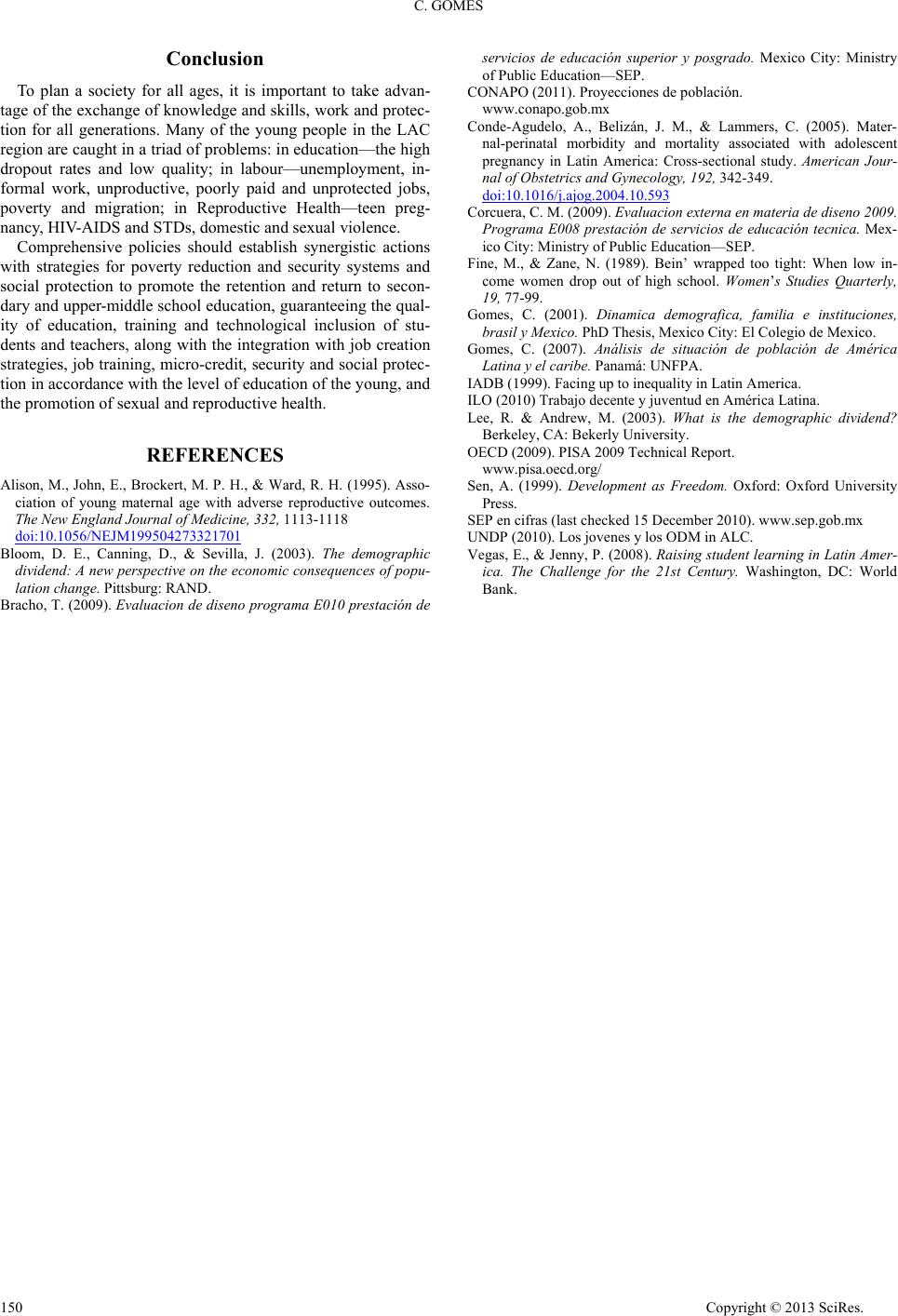 C. GOMES Copyright © 2013 SciRe s . 150 Conclusion To plan a society for all ages, it is important to take advan- tage of the exchange of knowledge and skills, work and protec- tion for all generations. Many of the young people in the LAC region are caught in a triad of problems: in education—the high dropout rates and low quality; in labour—unemployment, in- formal work, unproductive, poorly paid and unprotected jobs, poverty and migration; in Reproductive Health—teen preg- nancy, HIV-AIDS and STDs, domestic and sexual violence. Comprehensive policies should establish synergistic actions with strategies for poverty reduction and security systems and social protection to promote the retention and return to secon- dary and upper-middle school education, guaranteeing the qual- ity of education, training and technological inclusion of stu- dents and teachers, along with the integration with job creation strategies, job training, micro-credit, security and social protec- tion in accordance with the level of education of the young, and the promotion of sexual and reproductive health. REFERENCES Alison, M., John, E., Brockert, M. P. H., & Ward, R. H. (1995). Asso- ciation of young maternal age with adverse reproductive outcomes. The New England Journal of Medi c i ne, 332, 1113-1118 doi:10.1056/NEJM199504273321701 Bloom, D. E., Canning, D., & Sevilla, J. (2003). The demographic dividend: A new perspective on the economic consequences of popu- lation change. Pitts burg: RAND. Bracho, T. (2009). Evaluacion de diseno programa E010 prestación de servicios de educación superior y posgrado. Mexico City: Ministry of Public Education—SEP. CONAPO (2011). Proyecciones de población. www.conapo.gob.mx Conde-Agudelo, A., Belizán, J. M., & Lammers, C. (2005). Mater- nal-perinatal morbidity and mortality associated with adolescent pregnancy in Latin America: Cross-sectional study. American Jour- nal of Obstetrics and Gynecology , 192, 342-349. doi:10.1016/j.ajog.2004.10.593 Corcuera, C. M. (2009). Evaluacion externa en materia de diseno 2009. Programa E008 prestación de servicios de educación tecnica. Mex- ico City: Ministry of Public Education—SEP. Fine, M., & Zane, N. (1989). Bein’ wrapped too tight: When low in- come women drop out of high school. Women’s Studies Quarterly, 19, 77-99. Gomes, C. (2001). Dinamica demografica, familia e instituciones, brasil y Mexico. PhD Thesis, Mexico City: El Colegio de Mexico. Gomes, C. (2007). Análisis de situación de población de América Latina y el caribe. Panamá: UNFPA. IADB (1999). Facing up to inequality in Latin America. ILO (2010) Trabajo decente y juventud en América Latina. Lee, R. & Andrew, M. (2003). What is the demographic dividend? Berkeley, CA: Bekerly University. OECD (2009). PISA 20 0 9 Technical Report. www.pisa.oecd.org/ Sen, A. (1999). Development as Freedom. Oxford: Oxford University Press. SEP en cifras (last checked 15 December 2010). www.sep.gob.mx UNDP (2010). Los jovenes y los ODM in ALC. Vegas, E., & Jenny, P. (2008). Raising student learning in Latin Amer- ica. The Challenge for the 21st Century. Washington, DC: World Bank.
|